► Mezger-designed, 4.5-litre flat-12
► Wins Le Mans for the first time in 1970
► The Porsche 917 marks 50 years in 2019
This year marks 50 years of the Porsche 917, and Stuttgart is making a very big deal about it. Over the last few months, we’ve seen the 917 at Goodwood Members’ meeting – and even pictured next to Concorde, which also celebrates 50 years in 2019, too. The mint chassis 001 of the 917 has been at the heart of the celebrations, and now Porsche has revealed more details of its lengthy restoration process.
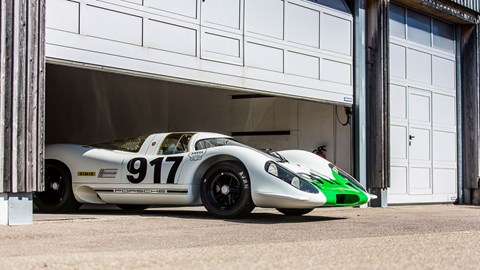
After being shown at the Geneva motor show of 1969, Porsche says the first technical assessment began on January 2018. The car was converted from short-tail spec back to long-tail as it was originally shown, and while the car’s aluminum frame remains, a new rear frame had to be built for the car’s streamlined rear section. The roof, windscreen, doors and door frames were amazingly left untouched.
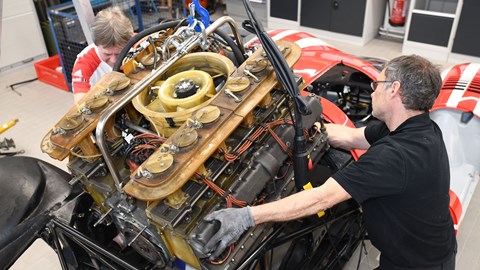
A month later, 917-001 was completely disassembled before being sanded, smoothed and then painted white. After that, the green ‘Geneva nose’ was added, and the 917 badge was applied.
As well as taking pictures of the car at Goodwood, and next to the Concorde, Porsche also recreated one of the most iconic recorded images of the 917; a line of the race cars awaiting inspection in 1969.
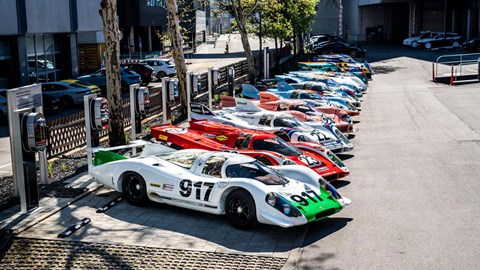
Porsche 917 and Concorde, because
It’s been 50 years since the iconic Porsche 917 first moved under its own power, and Stuttgart’s marketing department has been flat-out, reminding us of the fact. To celebrate half a century of one the brand’s most legendary cars, Porsche has taken 917 chassis 001 on a tour of the UK.
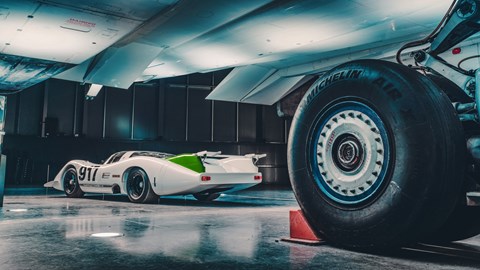
First it was driven at the 77th Goodwood Members’ meeting, and then it joined the Concorde – another engineering legend celebrating its 50th birthday this year. Turns out, the Concorde set off on its maiden flight from Bristol, and the very same month, Porsche began developing its 12-cylinder racecar. Tenuously linked? Yes. Interesting – also, yes.
Porsche took the 917 to Yeovilton to meet the last airframe of the supersonic jet to be flown – and also brought along Richard Attwood who won Le Mans with the car in 1970. There, he had a chat with Captain Tim Orchard, ex-Concorde pilot and record-holder for the quickest commercial flight between New York and London.
‘Like a lot of people I’m a big fan of Concorde and always wish I could have flown on her – I’ve missed my chance,’ said Attwood. ‘The 917 and Concorde seem so pure and simple from the outside, but both mask an array of engineering ingenuity that is still extremely impressive by today’s standards.
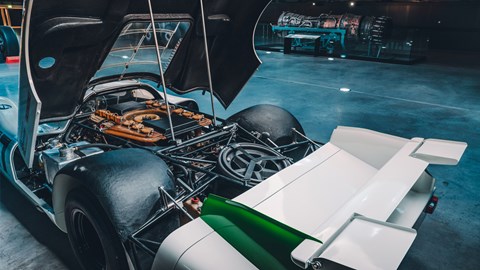
I would like to thank Tim for his time and patience in showing me around – I so enjoyed reminiscing about what it was like in the late 1960’s and early 1970’s and our belief that we could achieve just about anything if we put our minds to it.’
Keep reading for the full story on the legendary 917.
917: the story
The 917 almost never happened. Put off by the FIA’s requirement to build 50 examples for the 5.0-litre sports car class, Porsche instead created the 908 to compete in the 3.0-litre category. And even when that number was halved in the spring of 1968, it took the deep pockets of VW (who needed to promote the air-cooled engines of its ageing but profitable Beetle) to fund two-thirds of the race programme.
Although the 917 looks like an iconic racing car now – and integral part of Porsche’s racing history – back in the late ’60s it was a revolutionary piece of machinery, and totally different from what came before. Its ingenuity wasn’t lost on the drivers either: ‘Suddenly this bloody 12-cylinder comes out, I mean where really did that come from,’ Bell remembers. ‘And what a gamble, absolutely amazing.’
Porsche’s tiny team started work in July ’68. A tubular aluminium-alloy chassis meant the 917 weighed just 800kg. Engine designer Hans Mezger added four cylinders to the 908’s motor to create a lightweight and incredibly reliable 180° flat-12.
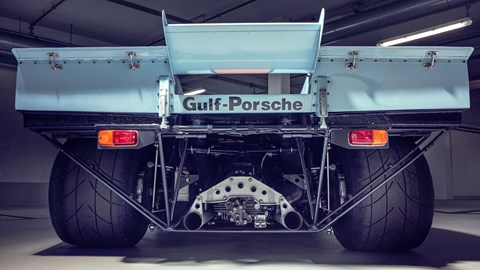
All great legends have an unlikely, unexpected backstory behind them – and the 917 was no different. ‘When the CSI came [what they called the then equivalent of the FIA] and went down the line it turned out they were 10 engines short or something – or so the story goes,’ says Bell. ‘So they said, right, you’ve got two months to get the other 10 engines in, and there was a right bloody panic to get them ready for the first race in March… It was a right feat to get those 10 engines built.’
But less than a year after the project was given the green light, Porsche presented the 917; and it was a dog. It led at Le Mans that year, but when Richard Attwood retired from the race with three hours to go, his only emotion was relief. ‘It was the worst time I ever had in a race car,’ he told CAR. ‘It was all over the place at 180mph but it could do 235mph…’
Silver linings
The virtually untested 917 had set a lap record in qualifying and the fastest lap of the race, and when Porsche went testing in October 1969, it discovered the problem. Aerodynamics in those days really were a black art, and the team used tin snips and aluminium sheet to raise the bodywork above the rear wheels. It worked, creating much-needed downforce.
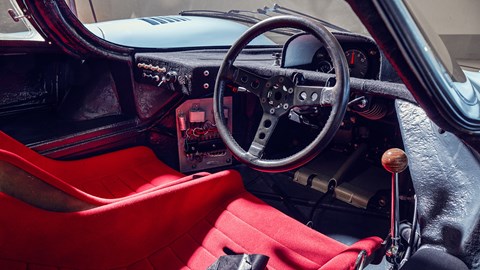
‘We made it a perfect car, the opposite of before,’ beams driver Hans Herrmann. At Le Mans in 1970 he and Attwood finished first, with another 917 in second (and a 908 in third). In 1971 it was Porsche atop the podium again, this time with Helmut Marko (the old guy in the Red Bull pit garage at F1 races) and Gijs van Lennep at the wheel.
The pair also set speed and distance records in the race that wouldn’t be beaten until 2010. And they did it in a special 917 with a super-lightweight magnesium frame so fragile it cracked during testing and never raced again after Le Mans. Porsche was so worried the pair might nurse it round for 24 hours, it simply didn’t tell the drivers about the one-off chassis until after the chequered flag.
‘It was an amazing era of sportscar racing for so many years,’ adds Derek Bell, and we’re inclined to agree. Rules still restricted manufactures, but there was a great sense of freedom in cars those days – and reliability really wasn’t taken for granted. ‘Every race they’d cross their fingers that at the end of it the car hadn’t fallen apart, says Derek Bell. ‘ I mean seriously!’
The Gulf car (chassis 15), has a special story, too:
‘They brought it to Goodwood (Festival of Speed), I drove it and it was Chassis 15; and the amazing thing about that chassis is that I had test driven it in September 1970 for Porsche at Goodwood. That was the first 917 I ever sat in, and I didn’t realise it.’
‘If you look at the records, which I did ultimately, I realised I didn’t drive it much – Pedro [Rodriguez] drove it more and that’s why it had #21 on it. That’s the car that won Daytona.’
The 917 continues
Those initial victories weren’t blips. Le Mans was part of the Sports Car World Championship, and the 917 won seven out of the eight races it entered in 1970. A year later it was no different: eight from 10.
A rule change at the end of ’71 killed the 5.0-litre Group 5 sports cars, so Porsche focused on the fearsome North American Can-Am championship. With no engine limits, the turbocharged 1000bhp 917/10 Spyder ended McLaren’s dominance in ’72, and eight wins out of eight for the 917/30 Spyder in ’73 meant the rules were re-written to stop it coming back. That decision killed Can-Am, while Porsche’s experiment with turbocharging led to the 911 Turbo – result.
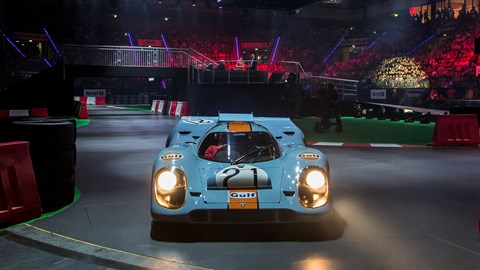
In various guises the 917 dominated the Interserie (Europe’s version of Can-Am) too, and its suspension, brakes and wheels were used to build the 936 Spyder, which won Le Mans in 1976.
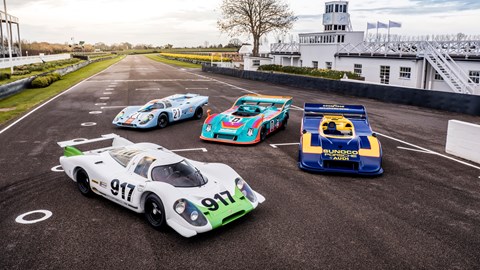
And 1977. In 1981, when the rules allowed for a bigger engine, Porsche pulled a 936 out of its museum, dropped in a turbocharged 2.65-litre from an old IndyCar project that never raced (another Mezger engine) along with the gearbox from a 917 Can-Am racer, and won.
Not bad for a car that nearly didn’t see the light of day.